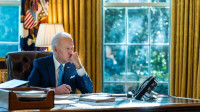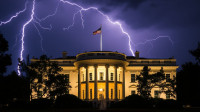In this Article:
- What is the slow-motion coup, and how did it begin with the Powell Memo?
- How has the Heritage Foundation executed this decades-long agenda?
- What is Project 2025, and why is it critical to understand its implications?
- How does this coup affect democracy, labor rights, and inequality?
- Can the tide be turned against this corporate takeover?
A Slow-motion Coup d'état
by Robert Jennings
It is the year 2025. Will the policies of a second Trump administration take hold, reshaping America in profound ways? Will environmental regulations be gutted, executive power centralized, and labor protections erode at a pace not seen since the early 20th century? The planned agenda is not the haphazard chaos like the first term. It is meticulous, calculated, and the product of decades of planning by a powerful conservative machine—one built on the framework of a 1971 corporate manifesto known as the Powell Memo.
How did we get here? How did the seeds planted in the Nixon era grow into this fully realized blueprint for dismantling the New Deal and beyond? The story begins with a strategy that sought to consolidate corporate power and reshape the very foundation of American democracy, all financed and guided by the heirs of the economic elite FDR once called the “Economic Royalists.”
A Blueprint for Corporate Power
In August 1971, Lewis Powell, a corporate lawyer and future Supreme Court justice, drafted a confidential memorandum at the request of the U.S. Chamber of Commerce. Titled “Attack on the American Free Enterprise System,” the Powell Memo was a clarion call for business leaders to take an active role in shaping politics, media, and academia. Powell argued that free enterprise was under siege from progressive movements and government regulation and that corporate America needed a coordinated defense to preserve its interests.
Powell’s strategy was revolutionary. He envisioned a network of think tanks, lobbying firms, and legal institutions to champion deregulation, free markets, and limited government intervention. The memo wasn’t merely reactive but a blueprint for an aggressive offensive. Over the next decades, Powell’s vision materialized, with billions of dollars from corporate donors and conservative billionaires pouring into organizations that would carry out his agenda.
Building the Infrastructure
Established in 1973, the Heritage Foundation became one of the most powerful instruments of the Powell Memo’s vision. With substantial funding from wealthy individuals and corporations, Heritage set out to influence policy by providing detailed legislative proposals, research, and media messaging tailored to conservative goals. Its success was evident in the Reagan administration. Heritage played a pivotal role in shaping economic policy, including massive tax cuts for the wealthy and deep cuts to social programs.
But Heritage wasn’t just a policy shop but a strategic weapon. It cultivated relationships with lawmakers, coordinated messaging across conservative media, and established itself as the intellectual backbone of the Republican Party. By the 1980s, the Powell Memo’s call for a unified corporate agenda had evolved into a sophisticated network of influence, with the Heritage Foundation at its core.
From Reagan to Trump
Ronald Reagan’s presidency marked a turning point, as the policies championed by the Heritage Foundation and other conservative groups became mainstream. Reagan’s tax cuts, deregulation, and anti-labor policies embodied the Powell Memo’s vision. But Reagan’s presidency also set the stage for a deeper transformation, where populist rhetoric would mask policies that primarily benefited the wealthy.
Project 2025 is not the first comprehensive policy blueprint crafted by the Heritage Foundation. Since its founding in 1973, the organization has consistently produced detailed roadmaps for Republican administrations, starting with Ronald Reagan. These documents served as ideological and practical playbooks, guiding policy decisions and aligning them with limited government, deregulation, and free-market economics principles.
In 1980, the Heritage Foundation released its seminal report, Mandate for Leadership: Policy Management in a Conservative Administration, a 1,000-page document designed to shape the incoming Reagan administration’s agenda. This report became a cornerstone of Reagan’s presidency, influencing key policies like tax cuts, deregulation, and reductions in social programs. Reagan’s adoption of Heritage’s recommendations marked the organization’s first major success in embedding its ideology into federal governance.
Similar blueprints followed for subsequent Republican administrations. Each report tailored its recommendations to the political climate of the time but adhered to the same underlying principles. For George H.W. Bush, the focus shifted to managing the post-Cold War transition while maintaining conservative fiscal policies. Under George W. Bush, Heritage promoted tax cuts, education reform through No Child Left Behind, and a robust national security agenda after 9/11. These reports served as strategic guides and ideological manifestos, reinforcing the Powell Memo’s vision of corporate dominance and limited government intervention.
By the time Donald Trump assumed office in 2017, the Heritage Foundation’s influence was stronger than ever. It provided the Trump administration with a policy blueprint that included sweeping deregulation, conservative judicial appointments, and tax cuts for corporations and the wealthy. The success of these efforts laid the groundwork for Project 2025, which represents the culmination of decades of strategic planning and incremental gains. Far from being a one-off initiative, Project 2025 is the latest in a series of efforts designed to entrench conservative policies and dismantle progressive achievements.
Decades of corporate consolidation, judicial shifts, and the erosion of labor power created a landscape ripe for exploitation. Trump’s populist messaging and his alignment with corporate interests made him the perfect figurehead for this movement. He championed policies that widened inequality and dismantled democratic norms while claiming to be a voice for the “forgotten man.”
Project 2025: The Crown Jewel
Project 2025, unveiled by the Heritage Foundation, culminates this decades-long effort. It provides a detailed roadmap for a second Trump term, focusing on consolidating executive power, rolling back environmental protections, and gutting labor rights. It is not a scattershot collection of ideas; it is a comprehensive plan designed to entrench corporate dominance and weaken democratic institutions further.
The Heritage Foundation’s role in crafting this agenda underscores the continuity of the Powell Memo’s influence. Project 2025 is a testament to corporate America's long-term planning and investment power, financed and guided by the heirs of FDR’s “Economic Royalists.”
The Strategic Agendas
The path from the Powell Memo to Project 2025 was not linear but multifaceted, marked by overlapping strategies to undermine progressive gains. Key elements included:
- Dismantling Labor: Efforts to weaken unions, reduce workers’ rights, and shift economic power away from collective bargaining to corporate interests.
- Judicial Influence: A decades-long campaign to fill the judiciary with conservative judges ruling in favor of deregulation, corporate power, and limited government oversight.
- Media Domination: The creation and expansion of right-wing media empires that reframed public discourse to align with corporate and conservative values.
- Undermining Trust: Strategies to delegitimize government institutions and foster public cynicism, making it harder for progressive policies to gain traction.
Each agenda was meticulously designed to erode the legacy of the New Deal, fragmenting the progress made under FDR and paving the way for an America shaped by corporate priorities.
The Cost of the Revolution
If Trump fully implements the policies championed by the Heritage Foundation, it will exact a steep toll. Rising inequality, declining labor protections, and the erosion of public trust in government have already fractured the nation. The very institutions that once served as bulwarks of democracy now teeter under the weight of corporate influence and authoritarianism.
What began as a reaction to the progressive gains of the New Deal has transformed into an attempt to dismantle those achievements fully. The cost of this revolution is borne not by the wealthy who funded it but by ordinary Americans struggling in an increasingly unequal and unstable society.
Franklin Delano Roosevelt warned of the dangers of concentrated wealth and unchecked corporate power. His battle against the “Economic Royalists” was a policy fight and a moral crusade to protect democracy. Today, as the Powell Memo’s shadow looms large over American politics, the need for FDR’s clarity and courage has never been greater.
Understanding the path from the Powell Memo to Project 2025 is essential to countering its effects. It is a story of how long-term planning, strategic investment, and the relentless pursuit of power can reshape a nation. But it is also a reminder that change is possible when leadership rises to meet the moment.
As Project 2025 takes shape, the stakes could not be higher. If left unchecked, it threatens to cement a corporate-controlled vision of America that undermines democracy and deepens inequality. But the same forces that brought us to this point can be countered. Just as the Powell Memo’s vision required decades of commitment, reclaiming America’s future demands bold leadership, strategic planning, and a renewed focus on the needs of the many over the interests of the few.
The path forward is clear. It requires resistance and a revival of the moral and rhetorical clarity that defined FDR’s leadership. The question is whether America will rise to the occasion—or succumb to the shadow of its past.
About the Author
 Robert Jennings is the co-publisher of InnerSelf.com, a platform dedicated to empowering individuals and fostering a more connected, equitable world. A veteran of the U.S. Marine Corps and the U.S. Army, Robert draws on his diverse life experiences, from working in real estate and construction to building InnerSelf with his wife, Marie T. Russell, to bring a practical, grounded perspective to life’s challenges. Founded in 1996, InnerSelf.com shares insights to help people make informed, meaningful choices for themselves and the planet. More than 30 years later, InnerSelf continues to inspire clarity and empowerment.
Robert Jennings is the co-publisher of InnerSelf.com, a platform dedicated to empowering individuals and fostering a more connected, equitable world. A veteran of the U.S. Marine Corps and the U.S. Army, Robert draws on his diverse life experiences, from working in real estate and construction to building InnerSelf with his wife, Marie T. Russell, to bring a practical, grounded perspective to life’s challenges. Founded in 1996, InnerSelf.com shares insights to help people make informed, meaningful choices for themselves and the planet. More than 30 years later, InnerSelf continues to inspire clarity and empowerment.
Creative Commons 4.0
This article is licensed under a Creative Commons Attribution-Share Alike 4.0 License. Attribute the author Robert Jennings, InnerSelf.com. Link back to the article This article originally appeared on InnerSelf.com
Article Recap
The Powell Memo sparked a slow-motion coup that has gradually dismantled the pillars of democracy. Through decades of calculated strategies led by the Heritage Foundation, corporate interests have reshaped politics and policy in America. Now, Project 2025 represents the culmination of this agenda, threatening to deepen inequality and consolidate power. Understanding this history is key to resisting its continued impact.
#SlowMotionCoup #PowellMemo #HeritageFoundation #Project2025 #DemocracyUnderThreat #CorporateTakeover








